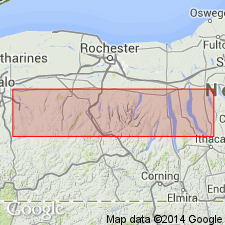
- Usage in publication:
-
- Cottage City Coral Beds
- Modifications:
-
- Named
- Dominant lithology:
-
- Limestone
- AAPG geologic province:
-
- Appalachian basin
Summary:
Highest fossil-rich unit of the Jaycox Member of the Ludlowville Formation in western NY is here designated the Cottage City Coral Beds for exposures on Deep Run near Cottage City, Ontario Co., western NY. Unit consists of thin beds usually rich in large rugose and tabulate corals. At the type section, unit is 93.5 cm thick and is marked by two coral-bearing beds interspersed with calcareous mudstone rich in brachiopods, bryozoans, and pelmatozoan debris. Beds are traceable from Hill's Gulch eastward at least as far as Seneca Lake. Unit thickens erratically eastward from 35 cm at Hill's Gulch to a maximum of 207.5 cm at Hopewell Gully east of Canandaigua. In general, the uppermost bed is the richest in fossils and contrasts sharply with the overlying fossil-poor Benton Run Mudstone [bed] (new), the uppermost division of the Jaycox. Overlies a barren shale interval. Age is Middle Devonian.
Source: GNU records (USGS DDS-6; Reston GNULEX).
For more information, please contact Nancy Stamm, Geologic Names Committee Secretary.
Asterisk (*) indicates published by U.S. Geological Survey authors.
"No current usage" (†) implies that a name has been abandoned or has fallen into disuse. Former usage and, if known, replacement name given in parentheses ( ).
Slash (/) indicates name conflicts with nomenclatural guidelines (CSN, 1933; ACSN, 1961, 1970; NACSN, 1983, 2005, 2021). May be explained within brackets ([ ]).

